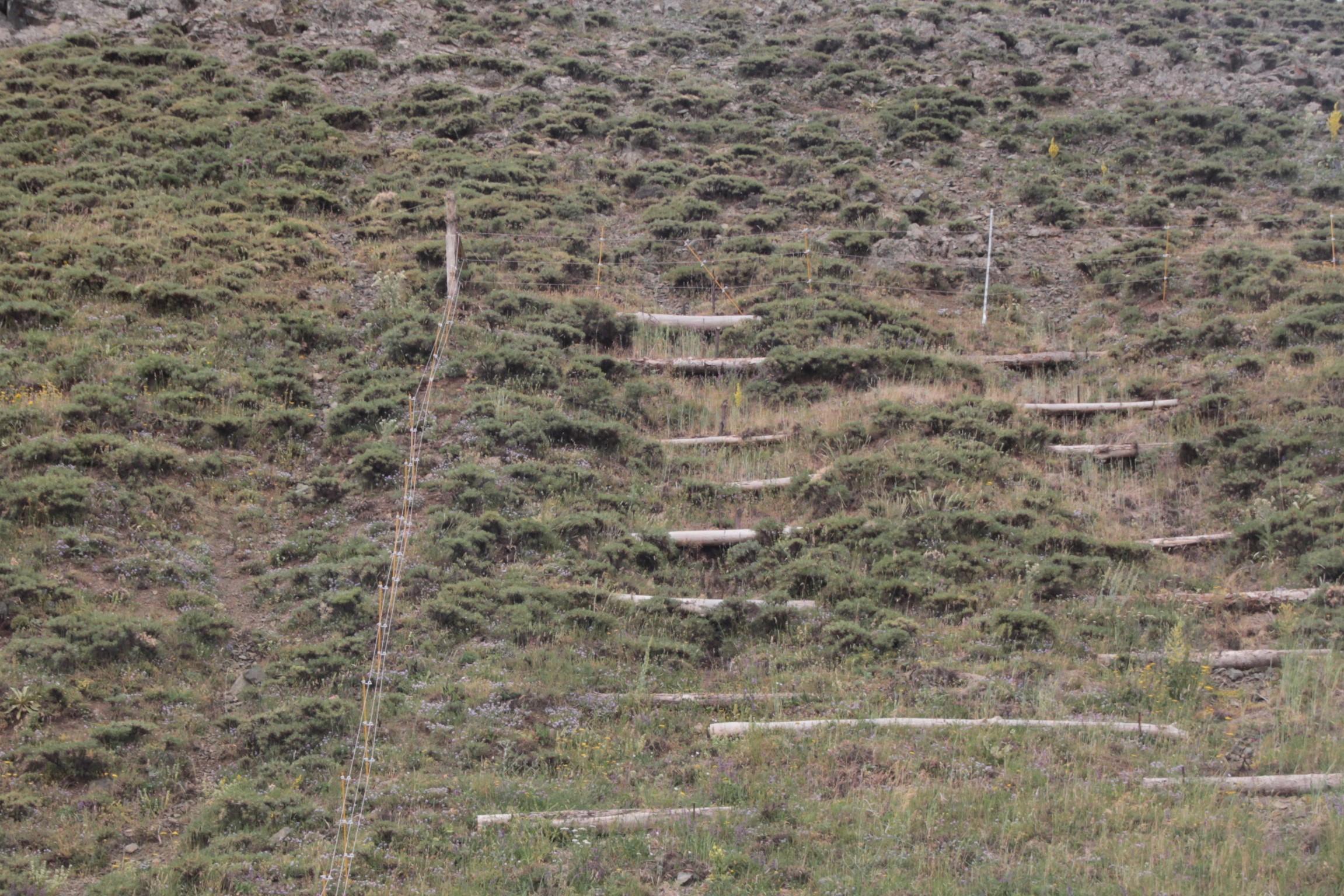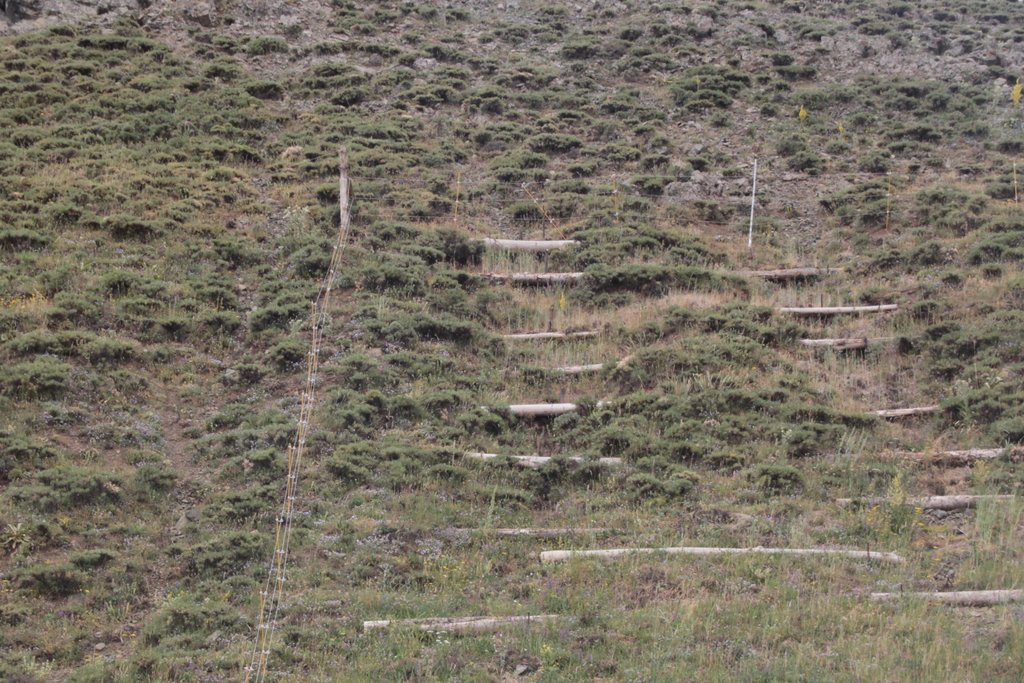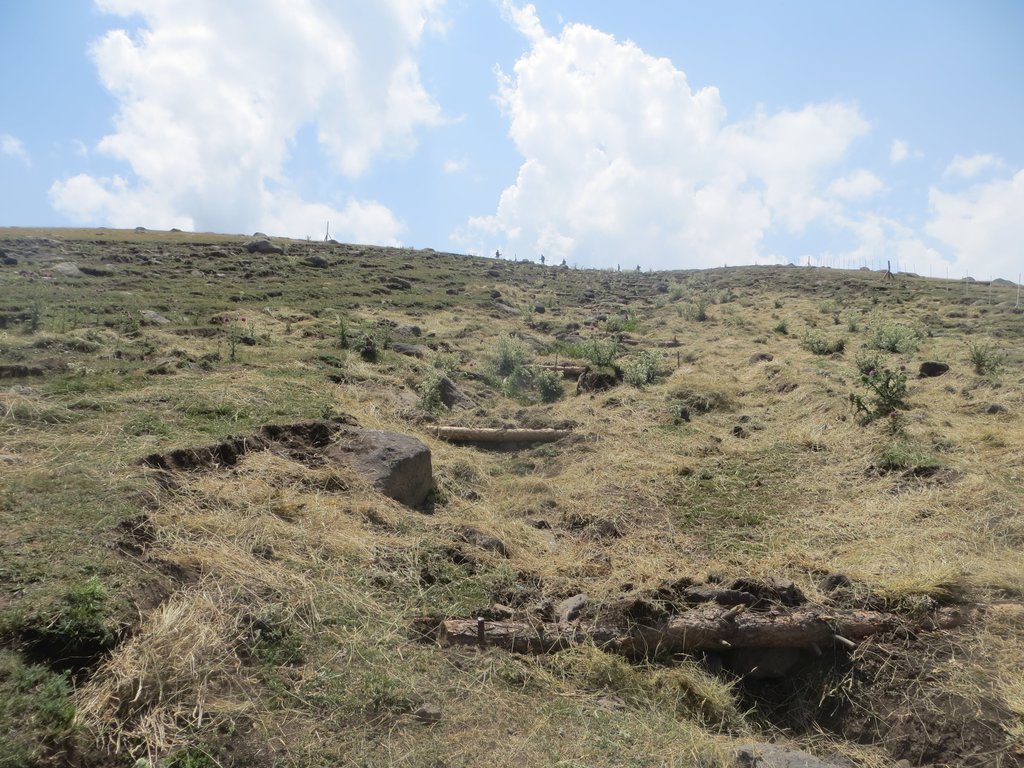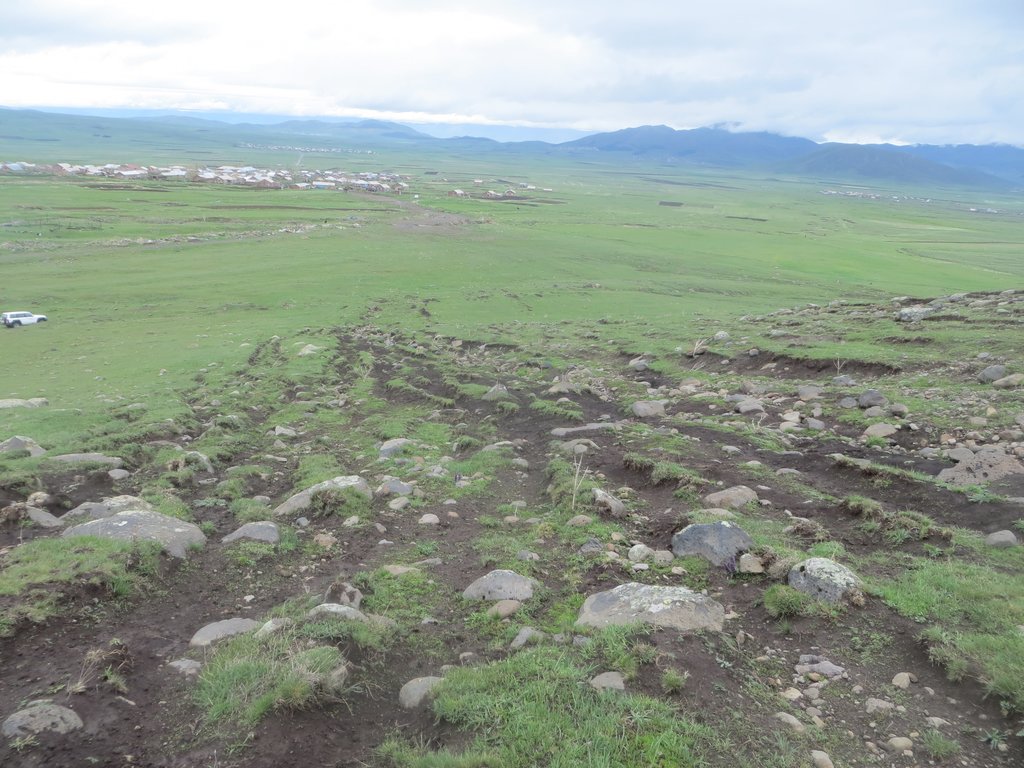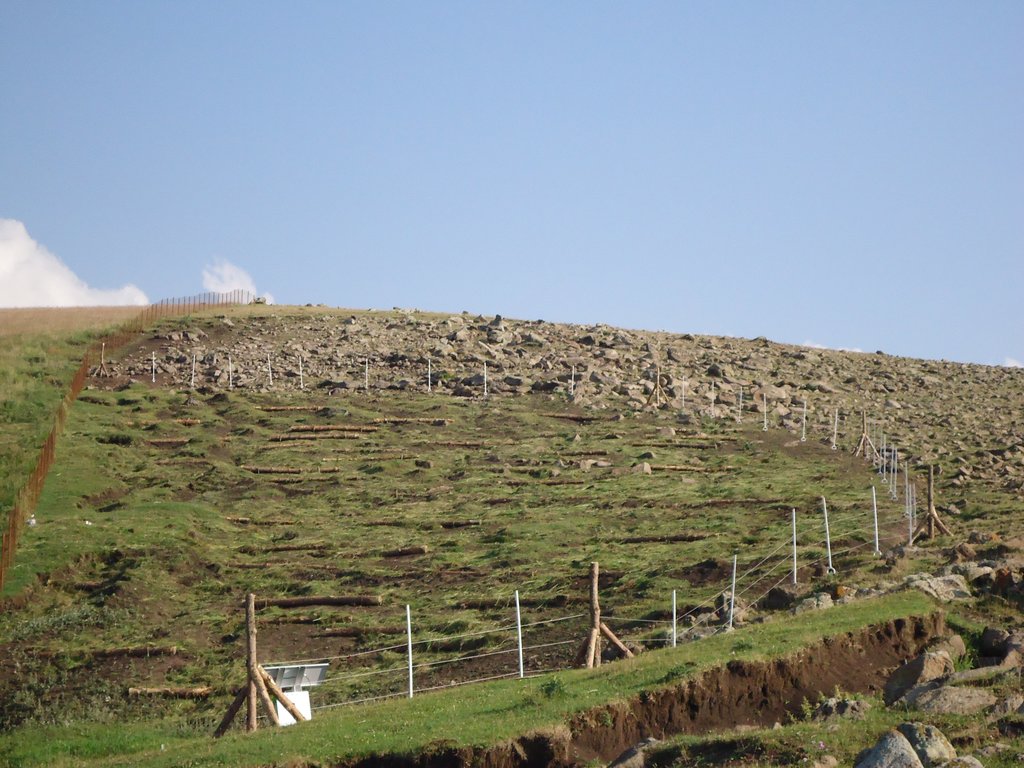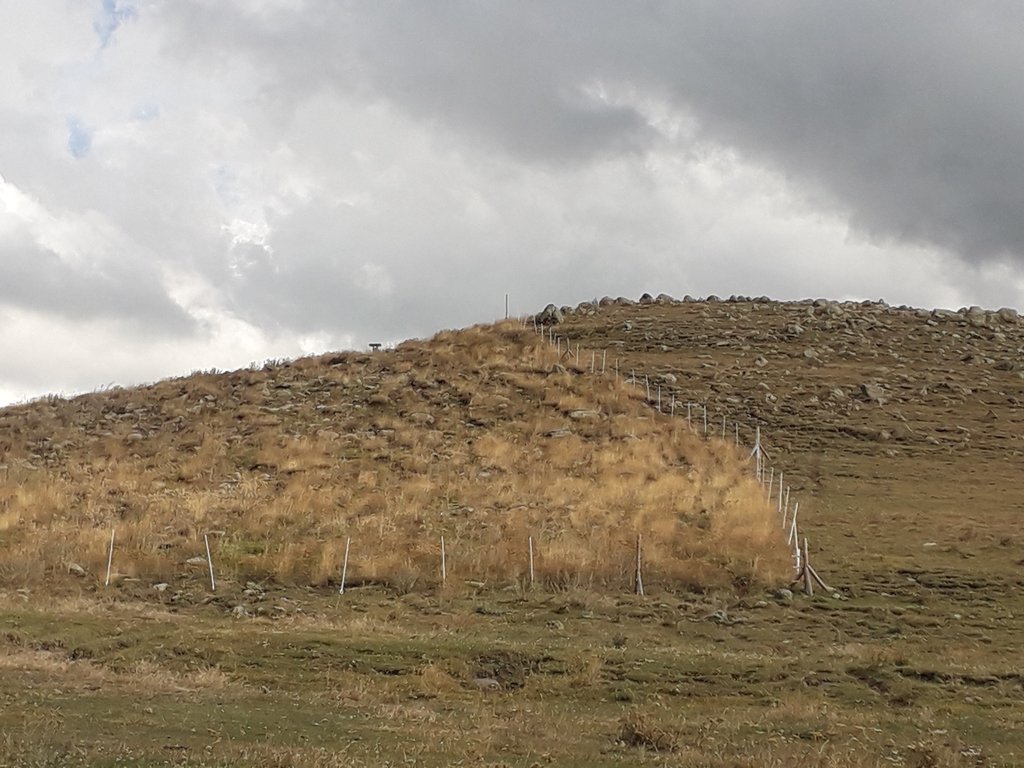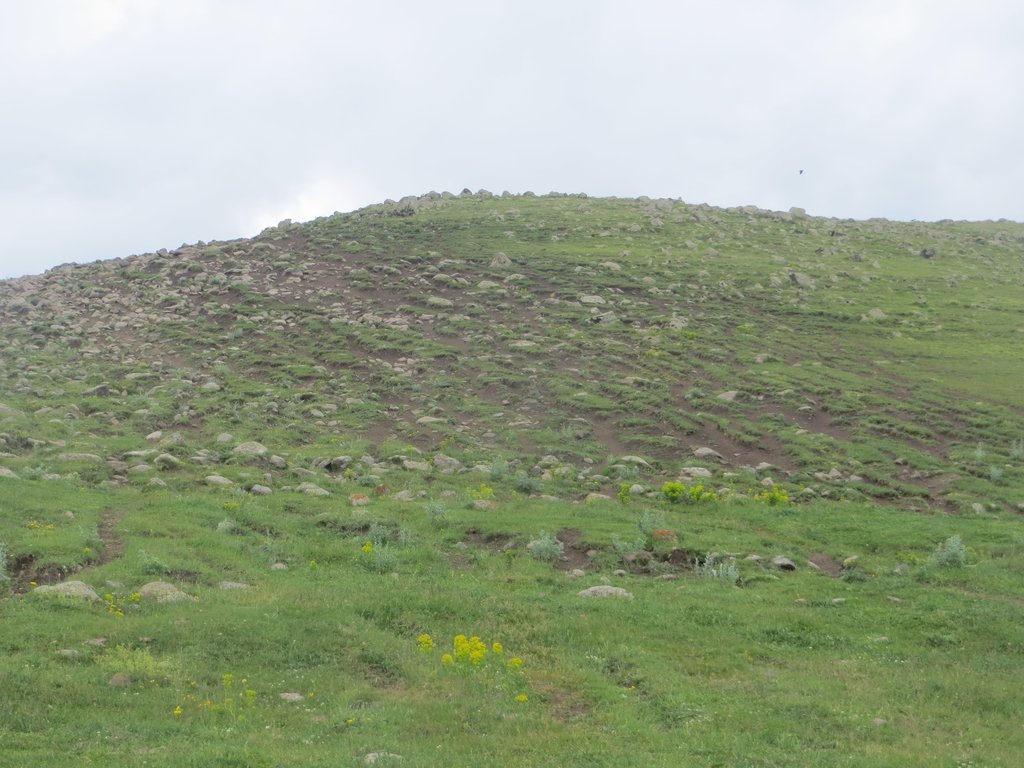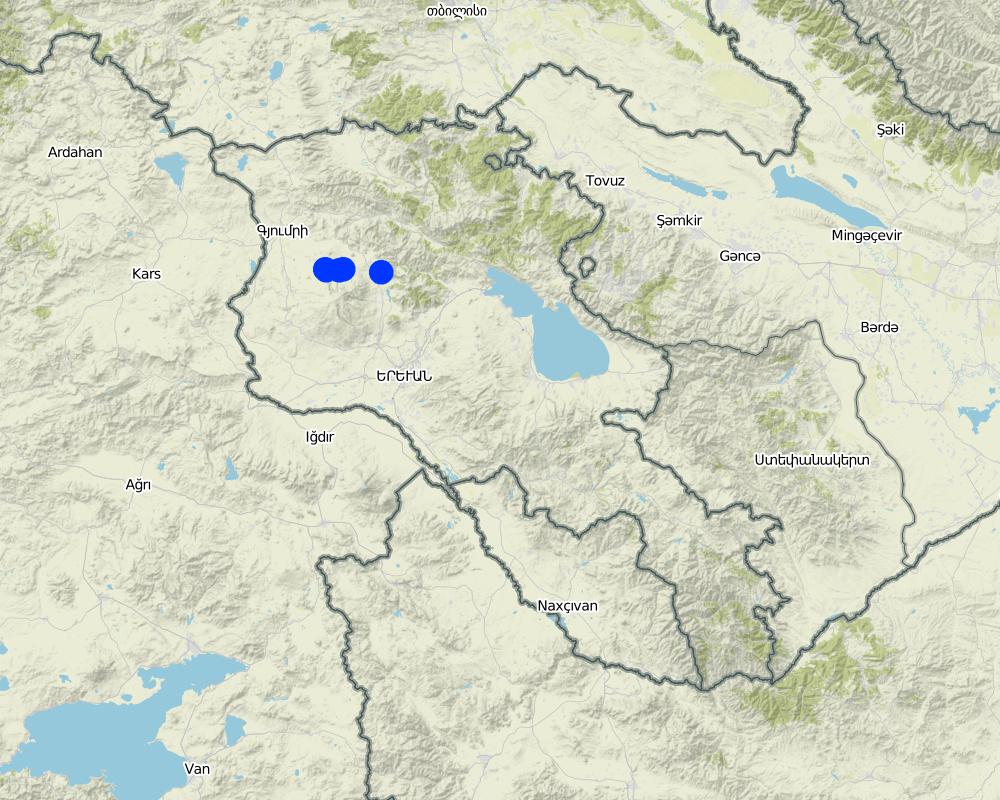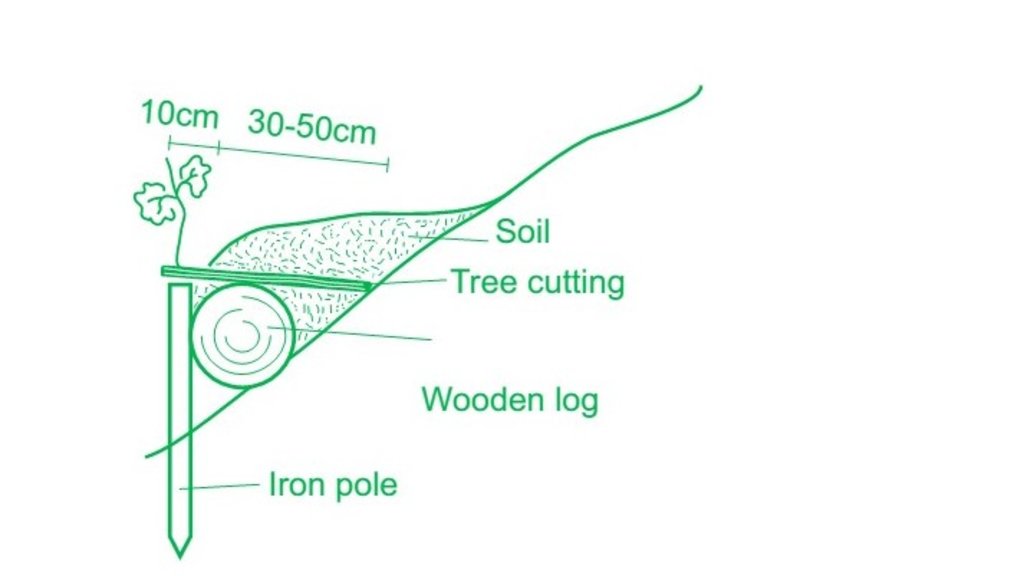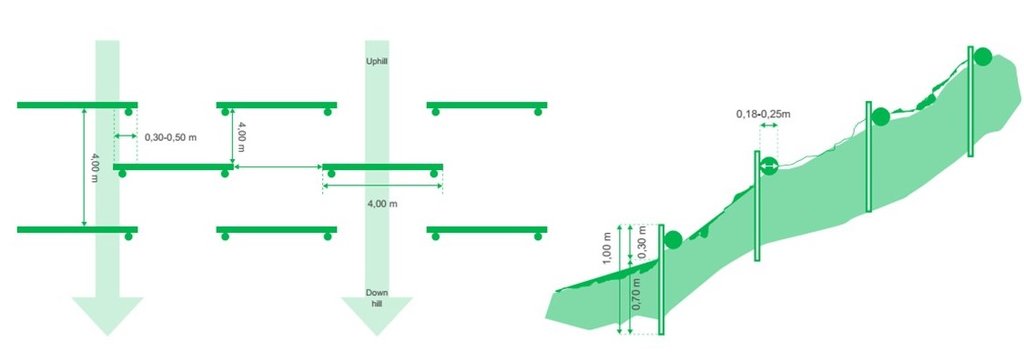Slope erosion control using wooden pile walls [ប្រទេសអាមេនី]
- ការបង្កើត៖
- បច្ចុប្បន្នភាព
- អ្នកចងក្រង៖ Hanns Kirchmeir
- អ្នកកែសម្រួល៖ Artur Hayrapetyan
- អ្នកត្រួតពិនិត្យ Ursula Gaemperli
technologies_4092 - ប្រទេសអាមេនី
ពិនិត្យមើលគ្រប់ផ្នែក
ពង្រីកមើលទាំងអស់ បង្រួមទាំងអស់1. ព័ត៌មានទូទៅ
1.2 ព័ត៌មានលម្អិតពីបុគ្គលសំខាន់ៗ និងស្ថាប័នដែលចូលរួមក្នុងការវាយតម្លៃ និងចងក្រងឯកសារនៃបច្ចេកទេស
បុគ្គលសំខាន់ម្នាក់ (ច្រើននាក់)
អ្នកជំនាញឯកទេស SLM:
Mnatsyan Aghasi
+374 (0)96001193
aghasi.mnatsyan@giz.de
GIZ
4/1 Baghramyan Street, 0019 Yerevan, Armenia
ប្រទេសអាមេនី
អ្នកជំនាញឯកទេស SLM:
Khachatryan Hrant
+374 94 839083 / +374 91 926092
hkhachatryan84@gmail.com
ESAC NGO, Armenian National Agrarian Univercity
Yerevan, Davit Anhaght 23
ប្រទេសអាមេនី
អ្នកជំនាញឯកទេស SLM:
Huber Michael
0043463504144-24
huber@e-c-o.at
E.C.O. Institute of Ecology
Lakeside B07b 9020 Klagenfurt
ប្រទេសអូទ្រីស
ឈ្មោះគម្រោងដែលបានចងក្រងឯកសារ/ វាយតម្លៃលើបច្ចេកទេស (បើទាក់ទង)
Integrated Biodiversity Management, South Caucasus (IBiS)ឈ្មោះអង្គភាពមួយ (ច្រើន) ដែលបានចងក្រងឯកសារ/ វាយតម្លៃបច្ចេកទេស (បើទាក់ទង)
Deutsche Gesellschaft für Internationale Zusammenarbeit (GIZ)1.3 លក្ខខណ្ឌទាក់ទងទៅនឹងការប្រើប្រាស់ទិន្នន័យដែលបានចងក្រងតាមរយៈ វ៉ូខេត
តើពេលណាដែលទិន្នន័យបានចងក្រង (នៅទីវាល)?
03/10/2018
អ្នកចងក្រង និង(បុគ្គលសំខាន់ៗ)យល់ព្រមទទួលយកនូវលក្ខខណ្ឌនានាទាក់ទងទៅនឹងការប្រើប្រាស់ទិន្នន័យដែលបានចងក្រងតាមរយៈវ៉ូខេត:
បាទ/ចា៎
1.4 សេចក្តីប្រកាសស្តីពីចីរភាពនៃការពណ៌នាពីបច្ចេកទេស
តើបច្ចេកទេសដែលបានពណ៌នានេះមានបញ្ហាដែលផ្តោតលើការធ្លាក់ចុះគុណភាពដី, បើដូច្នេះវាមិនអាចត្រូវបានប្រកាសថាជាបច្ចេកទេសនៃការគ្រប់គ្រងប្រកបដោយចីរភាពទេ?
ទេ
1.5 ការយោងទៅលើកម្រងបញ្ជីសំណួរនៃវិធីសាស្ត្រផ្សព្វផ្សាយ SLM
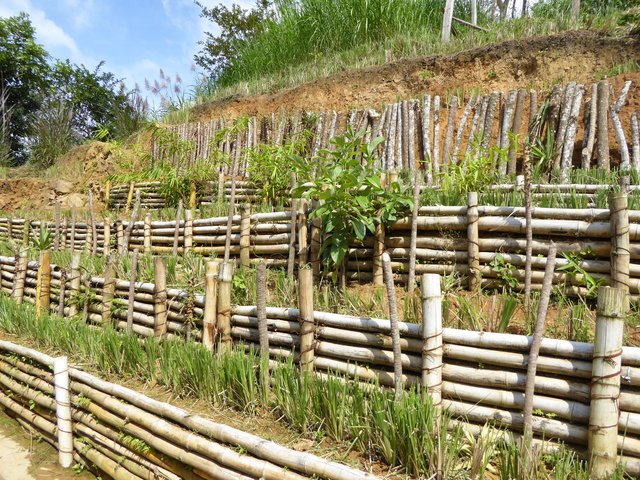
Estabilización de laderas de manera participativa [ប្រទេសហុងឌូរ៉ាស]
La bioingeniería comprende una serie de técnicas que utilizan materiales vegetativos vivos para prevenir la erosión y el deslizamiento de laderas y taludes. Las obras de bioingeniería se aplican a base de un análisis integrado de riesgo, son de multi-uso en su conjunto, tienen un bajo costo de construcción y …
- អ្នកចងក្រង៖ Helen Gambon
2. ការពណ៌នាពីបច្ចេកទេស SLM
2.1 ការពណ៌នាដោយសង្ខេបពីបច្ចេកទេស
និយមន័យបច្ចេកទេស:
Small horizontal wooden structures and terraces on eroded slopes built to mitigate sheet or rill erosion and slow down water run-off. The technology is easy to apply and efficient to mitigate erosion processes of the upper soil layer and to stop small rock falls.
2.2 ការពណ៌នាលម្អិតពីបច្ចេកទេស
ការពណ៌នា:
In the provinces of Aragatsotn and Shirak in Armenia, the weather is cold and temperate with dry summer. Steep slopes, pastures and some autochthonous oak forests make up the area. Farmers make most of their income with grazing by manual labour. The carrying capacity of pastures in the vicinity is regularly exceeded, and they degrade more and more. In order to stabilize the steep eroded slopes, pile walls were established. Pile walls are horizontal constructions along a slope, functioning as erosion control measures by slowing down the superficial water runoff, retaining materials and supporting the rehabilitation of vegetation.
The major advantages are: It is not expensive since mostly locally available materials can be used, and a positive effect can already be observed within a year. Also, the pile walls can be established relatively easy without any need of heavy machinery or specific knowledge and, therefore, allow the involvement of the local population.
In the case of the implementation in Armenia, the exact location for the pilot measures was selected in such a way that grazing activities were almost not impaired. For temporary exclusion of livestock, electric fencing was used. Within the fenced area, pile walls were established in the washed-out rills along the slope to address the water erosion phenomena.
The technical requirements and workload for the construction of a pile wall are relatively low. The needed resources require iron piles, a hammer, wooden logs (or a bundle of branches) and tree cuttings. First, the wooden logs were cut in 1-2 m length to fit into the irregular rills of the slope. After identifying the locations of individual pile walls, the team fixed the logs with iron poles of about 70-100cm length. The distance between the pile walls varies between 1-3m, depending on the topography: the steeper the slope, the closer the distance. The space behind the logs was filled with soil, plant material and rocks to stabilize the construction and to reduce the risk of water washing out the soil and passing below the logs. As a last step, the terraces were covered with hay to provide protection against precipitation and to accelerate re-growth of grass through the seeds contained in the hay residuals.
Community members were surprised how easy and quick the pile walls could be established. A team of two workers established a pile wall within 30 min. Since these areas are usually intensively used and thus are of high importance for the community, even a temporary exclusion from use must be thoroughly discussed and agreed upon.
The measure slows down vertical water-run off and provides steps for cattle. Due to temporary fencing and the application of hay mulch vegetation is recovering on these parts.
2.3 រូបភាពនៃបច្ចេកទេស
2.4 វីដេអូនៃបច្ចេកទេស
ការពណ៌នាសង្ខេប:
https://www.youtube.com/watch?v=Apt2D9i18a0
ESAC Project Video
កាលបរិច្ឆេទ:
27/03/2018
ទីតាំង:
Argatsotn/Shirak Marz
ឈ្មោះអ្នកថតវីឌីអូ:
ESAC
2.5 ប្រទេស/តំបន់/ទីតាំងកន្លែង ដែលបច្ចេកទេសត្រូវបានអនុវត្ត និងបានគ្រប់ដណ្តប់ដោយការវាយតម្លៃនេះ
ប្រទេស:
ប្រទេសអាមេនី
តំបន់/រដ្ឋ/ខេត្ត:
Aragatsotn and Shirak Marzes (Provinces)
បញ្ជាក់បន្ថែមពីលក្ខណៈនៃទីតាំង:
Lusagyugyh, Hnaberd, Ghegadhzor, Saralandj, Mets Mantash
Map
×2.6 កាលបរិច្ឆេទនៃការអនុវត្ត
ប្រសិនបើមិនច្បាស់ឆ្នាំ សូមបញ្ជាក់កាលបរិច្ឆេទដែលប្រហាក់ប្រហែល:
- តិចជាង 10ឆ្នាំមុន (ថ្មី)
2.7 ការណែនាំពីបច្ចេកទេស
សូមបញ្ជាក់តើបច្ចេកទេសត្រូវបានណែនាំឱ្យអនុវត្តដោយរបៀបណា:
- តាមរយៈគម្រោង / អន្តរាគមន៍ពីខាងក្រៅ
3. ចំណាត់ថ្នាក់នៃបច្ចេកទេស SLM
3.1 គោលបំណងចម្បង (១ ឬច្រើន) នៃបច្ចេកទេសនេះ
- ធ្វើឱ្យប្រសើរឡើងនូវផលិតកម្ម
- កាត់បន្ថយ, បង្ការ, ស្តារឡើងវិញនូវការធ្លាក់ចុះគុណភាពដី
- អភិរក្ស/ធ្វើឱ្យប្រសើរឡើងជីវចម្រុះ
- កាត់បន្ថយហានិភ័យនៃគ្រោះមហន្តរាយ
3.2 ប្រភេទដីប្រើប្រាស់មួយប្រភេទ (ច្រើនប្រភេទ) ដែលបានអនុវត្តបច្ចេកទេស

ដីសម្រាប់ចិញ្ចឹមសត្វ
ដីវាលស្មៅធំៗ:
- ពាក់កណ្តាលពនេចរ
ប្រភេទសត្វ និងផលិតផលចម្បងៗ:
cattle (and sheep)
3.3 ព័ត៌មានបន្ថែមអំពីអ្នកប្រើប្រាស់ដី
ការផ្គត់ផ្គង់ទឹកនៅកន្លែងអនុវត្តបច្ចេកទេស:
- ទឹកភ្លៀង និងប្រព័ន្ធស្រោចស្រព
ចំនួនសារដែលដាំដំណាំក្នុងមួយឆ្នាំ:
- 1
ដង់ស៊ីតេនៃសត្វចិញ្ចឹម (បើពាក់ព័ន្ធ):
0.89-1.30 pasture load/ha
3.4 ក្រុម SLM ដែលបច្ចេកទេសស្ថិតនៅក្នុង
- កសិរុក្ខកម្ម (pastoralism) និងការគ្រប់គ្រងដីសម្រាប់ចិញ្ចឹមសត្វ
- ធ្វើឱ្យប្រសើរឡើងគម្របដី/ ដំណាំគម្របដី
- កាត់បន្ថយការរំខានដល់ដី
3.5 ការសាយភាយនៃបច្ចេកទេស
បញ្ជាក់ពីការសាយភាយនៃបច្ចេកទេស:
- ត្រូវបានផ្សព្វផ្សាយត្រឹមតំបន់មួយ
ប្រសិនបើបច្ចេកទេសត្រូវបានសាយភាយពាសពេញតំបន់ណាមួយ សូមកំណត់ទំហំផ្ទៃដីអនុវត្តន៍:
- < 0.1 គម2 (10 ហិកតា)
3.6 វិធានការ SLM ដែលបញ្ចូលនូវបច្ចេកទេស

វិធានការរុក្ខជាតិ
- V1: ឈើធំៗ និងដើមឈើតូចៗ
- V2: ស្មៅនិងរុក្ខជាតិៗដែលដុះមានអាយុមិនលើសពី 2ឆ្នាំ

វិធានការរចនាស័ម្ពន្ធ
- S1: ការធ្វើដីថ្នាក់ៗតាមជម្រាលភ្នំ
3.7 កំណត់ប្រភេទនៃការធ្លាក់ចុះគុណភាពដីសំខាន់ៗដែលបច្ចេកទេសនេះបានដោះស្រាយ

ការហូរច្រោះដីដោយសារទឹក
- Wt: ការបាត់ដីស្រទាប់លើដោយការហូរច្រោះ
- Wg: ការកកើតឡើងនូវកំទេចកំទីដីស្រទាប់ក្រោម
- Wm: ការបាក់ដី

ការបាត់ដីដោយសារខ្យល់
- Et: ការបាត់បង់ដីស្រទាប់លើ

ការបាត់បង់រូបសាស្ត្រនៃដី
- Pc: ការហាប់ណែន

ការធ្លាក់ចុះជីវសាស្ត្រនៃដី
- Bc: ការថយចុះនូវគម្របរុក្ខជាតិ
3.8 ការពារ កាត់បន្ថយ ឬស្តារឡើងវិញនៃការធ្លាក់ចុះគុណភាពដី
បញ្ជាក់ពីគោលដៅរបស់បច្ចេកទេស ដែលផ្តោតទៅការធ្លាក់ចុះគុណភាពដី:
- ការកាត់បន្ថយការធ្លាក់ចុះគុណភាពដី
- ការជួសជុល/ ស្តារឡើងវិញនៃឱនភាពដីធ្ងន់ធ្ងរ
4. បច្ចេកទេសជាក់លាក់ សកម្មភាពអនុវត្ត ធាតុចូល និងថ្លៃដើម
4.1 គំនូសបច្ចេកទេសនៃបច្ចេកទេសនេះ
4.2 លក្ខណៈពិសេសនៃបច្ចេកទេស/ ពណ៌នាពីគំនូរបច្ចេកទេស
Required materials for 1 pile wall:
- 2 iron poles (0.7-1m) and a hammer
- 1 wooden log (ca. 4 m, 20-25cm diameter)
- 10-20 shrub cuttings (e.g. Salix species)
Selection of appropriate sites for pile walls (where and how to put them):
The logs are being spread on the slope as indictated in the scheme of the figure. The steeper the slope the narrower the vertical spacing in between (max. 4m, min. 1-2 m). On uneven slopes, place the along the depressions as these are the areas where water-run off is strongest. Parts which show no erosion signs can be left out to not destroy existing vegetation cover. The location of the pile walls is determined by the slope and serves to stabilize the slope at superficial level (10-30 cm). It landslides occur that involve deeper soil layers, this technology is not efficient.
Building process:
After placing the logs, those are fixed with two irons at the end (alternatively wooden posts can be used as well). After fixing the logs, the space behind needs to be filled (slight terracing of the slope). Additionally, either shrub seedlings or living cuttings from species such as willows (ca. 50cm long, 2-5cm diameter) should be integrated. Finally, the open soil should be covered by a layer of 2-5 cm of hay/grass containing seeds and eventually additional seeds (from local species) to promote the re-establishment of vegetation. This has also the benefit that this cover keep humidity in the soil, which is particularly important in (semi-)arid areas.
Species used/density:
At least 20 cuttings per pile wall should be planted. Depending on the survival rates, it can be also more. Shrubs additionally stabilize the slope and are to some extent protected by the pile wall.
4.3 ព័ត៌មានទូទៅដែលពាក់ព័ន្ធនឹងការគណនាធាតុចូល និងថ្លៃដើម
កំណត់របៀបនៃការគណនាថ្លៃដើម និងធាតុចូល:
- ក្នុងតំបន់អនុវត្តបច្ចេកទេស
កំណត់ទំហំ និងឯកត្តាផ្ទៃដី:
0.15 ha
កំណត់រូបិយប័ណ្ណសម្រាប់ថ្លៃដើម:
- ដុល្លារអាមេរិក
កំណត់ថ្លៃឈ្នួលជាមធ្យមនៃការជួលកម្លាំងពលកម្មក្នុងមួយថ្ងៃ:
ca. 20 USD per worker and day (unskilled local workers), 120 USD per day (local expert)
4.4 សកម្មភាពបង្កើត
| សកម្មភាព | ប្រភេទវិធានការ | ពេលវេលា | |
|---|---|---|---|
| 1. | Selection of eroded sites and size | ការគ្រប់គ្រង | anytime |
| 2. | Clarification of land user rights | ការគ្រប់គ្រង | anytime |
| 3. | Calculate amount of logs and irons needed | ការគ្រប់គ្រង | anytime |
| 4. | Materials check: Local materials and procurement of other materials | ការគ្រប់គ្រង | anytime |
| 5. | Place logs on the eroded slope (favor depressions where water flows are) | រចនាសម្ព័ន្ធ | anytime (best in spring and autumn) |
| 6. | Fix logs with two iron poles at both sides of the log | រចនាសម្ព័ន្ធ | anytime (best in spring and autumn) |
| 7. | Fill the space behind the log with soil, rocks and (willow) cuttings | រចនាសម្ព័ន្ធ | early spring or late autumn (willow cuttings without leaves) |
| 8. | Flatten the area behind the log (small terracing) | រចនាសម្ព័ន្ធ | anytime (best in spring and autumn) |
| 9. | Use additional hay/grass mulch to cover open soil and add additional seeds | សារពើរុក្ខជាតិ | best in spring (alternatively in late autumn) |
| 10. | If it is grazing area: Fence the area for at least 2-3 vegetation periods | ការគ្រប់គ្រង | during grazing period |
4.5 ថ្លៃដើម និងធាតុចូលដែលត្រូវការសម្រាប់ការបង្កើតបច្ចេកទេស
| បញ្ជាក់ពីធាតុចូល | ឯកតា | បរិមាណ | ថ្លៃដើមក្នុងមួយឯកតា | ថ្លៃធាតុចូលសរុប | % នៃថ្លៃដើមដែលចំណាយដោយអ្នកប្រើប្រាស់ដី | |
|---|---|---|---|---|---|---|
| កម្លាំងពលកម្ម | Unskilled worker: Implementation of field measures | person days | 30,0 | 21,0 | 630,0 | 10,0 |
| កម្លាំងពលកម្ម | Skilled expert (Implementation supervision and project management | person days | 14,0 | 120,0 | 1680,0 | |
| កម្លាំងពលកម្ម | Transportation costs (truck, experts) | rental days | 12,0 | 54,0 | 648,0 | 10,0 |
| កម្លាំងពលកម្ម | Administration costs | month | 1,0 | 127,0 | 127,0 | |
| សម្ភារៈ | Consumables | set | 1,0 | 59,0 | 59,0 | 10,0 |
| សម្ភារៈ | Electric tools | set | 1,0 | 424,0 | 424,0 | 10,0 |
| សម្ភារៈ | P3800 Fence energizer + Box and equipment | set | 1,0 | 345,0 | 345,0 | |
| សម្ភារៈ | Solar Panel for fence energizer | piece | 1,0 | 233,0 | 233,0 | |
| សម្ភារៈ | Battery and fence tester | piece | 1,0 | 203,0 | 203,0 | |
| សម្ភារៈដាំដុះ | Cuttings (20 per pile wall) (not used as it is being grazed) | pieces | ||||
| សម្ភារៈដាំដុះ | Hay/grass for mulch cover (Bales ca.20kg) | kg | 800,0 | 0,08 | 64,0 | |
| សម្ភារៈសាងសង់ | Wooden logs (3m, 20cm diameter) | pieces | 50,0 | 17,0 | 850,0 | |
| សម្ភារៈសាងសង់ | Iron poles (0.7-1m, 10 mm diameter) | pieces | 150,0 | 2,1 | 315,0 | |
| សម្ភារៈសាងសង់ | Electric Fence Polywire | m | 1300,0 | 0,3 | 390,0 | |
| សម្ភារៈសាងសង់ | Electric Fence Corner donut insulator | pieces | 27,0 | 1,0 | 27,0 | |
| សម្ភារៈសាងសង់ | Earth stakes | pieces | 3,0 | 22,0 | 66,0 | |
| សម្ភារៈសាងសង់ | Electric Fence Spring Gate Set | piece | 1,0 | 42,0 | 42,0 | |
| សម្ភារៈសាងសង់ | Wooden Posts | pieces | 9,0 | 6,4 | 57,6 | 20,0 |
| ថ្លៃដើមសរុបក្នុងការបង្កើតបច្ចេកទេស | 6160,6 | |||||
ប្រសិនបើអ្នកប្រើប្រាស់ដីមិនមានថ្លៃដើម 100% សូមបញ្ជាក់ថានរណាដែលចំណាយថ្លៃដើមដែលនៅសល់:
GIZ Project
មតិយោបល់:
Initial costs were comparatively high as it is a pilot project. Thus, staff costs and the procurement of electric fence equipment made costs rather high. If materials can be obtained locally costs go down as far as 23 USD/pile wall (including material and work).
4.6 សកម្មភាពថែទាំ
| សកម្មភាព | ប្រភេទវិធានការ | ពេលវេលា/ ភាពញឹកញាប់ | |
|---|---|---|---|
| 1. | Regular check of fence | រចនាសម្ព័ន្ធ | Once per two weeks |
| 2. | Installation and deinstallation of electric fence | រចនាសម្ព័ន្ធ | Once per year |
| 3. | Changing the broken posts | រចនាសម្ព័ន្ធ | once per year |
| 4. | Optional refill of stones and/or soil if washed out | រចនាសម្ព័ន្ធ | twice per year |
មតិយោបល់:
Almost all maintenance activity refer to the maintenance of the electric fence (which is being removed in winter) and needs to be re-established during the grazing period. The pile wall itself does not need maintenance measures.
4.7 កំណត់ថ្លៃដើមសម្រាប់ការថែទាំ/ សកម្មភាពរបស់បច្ចេកទេស (ក្នុងរយៈពេលមួយឆ្នាំ)
| បញ្ជាក់ពីធាតុចូល | ឯកតា | បរិមាណ | ថ្លៃដើមក្នុងមួយឯកតា | ថ្លៃធាតុចូលសរុប | % នៃថ្លៃដើមដែលចំណាយដោយអ្នកប្រើប្រាស់ដី | |
|---|---|---|---|---|---|---|
| កម្លាំងពលកម្ម | Regular check of fence | workdays | 8,0 | 21,0 | 168,0 | 100,0 |
| កម្លាំងពលកម្ម | Installation and deinstallation of electric fence | workdays | 8,0 | 21,0 | 168,0 | 100,0 |
| កម្លាំងពលកម្ម | Changing the broken posts | workdays | 1,0 | 21,0 | 21,0 | 100,0 |
| កម្លាំងពលកម្ម | Optional refill of stones and/or soil if washed out | workdays | 3,0 | 21,0 | 63,0 | 100,0 |
| ថ្លៃដើមសរុបសម្រាប់ការថែទាំដំណាំតាមបច្ចេកទេស | 420,0 | |||||
4.8 កត្តាសំខាន់បំផុតដែលមានឥទ្ធិពលដល់ការចំណាយ
ពណ៌នាពីកត្តាប៉ះពាល់ចម្បងៗទៅលើថ្លៃដើម:
Grazing (if fencing is needed it is the most costly part)
Wooden logs (if bought). This can be turned to zero by either using local wood (if permitted) or bundles of branches of specific species (e.g. willows).
5. លក្ខណៈបរិស្ថានធម្មជាតិ និងមនុស្ស
5.1 អាកាសធាតុ
បរិមាណទឹកភ្លៀងប្រចាំឆ្នាំ
- < 250 មម
- 251-500 មម
- 501-750 មម
- 751-1,000 មម
- 1,001-1,500 មម
- 1,501-2,000 មម
- 2,001-3,000 មម
- 3,001-4,000 មម
- > 4,000 មម
កំណត់បរិមាណទឹកភ្លៀង (បើដឹង) ជា មីលីម៉ែត្រ:
521,00
លក្ខណៈពិសេស/ មតិយោបល់លើរដូវភ្លៀង:
In Aparan, the climate is cold and temperate. Aparan has a significant amount of rainfall during the year. This is true even for the driest month. Precipitation peaks are in May and June.
បញ្ជាក់ឈ្មោះឯកសារយោងនៃស្ថានីយឧតុនិយម:
Aparan, Aragatsotn Marz, Armenia
តំបន់កសិអាកាសធាតុ
- មានភ្លៀងតិចតួច
According to Köppen and Geiger, the climate is classified as Dfb (Cold/continental, no dry season, warm summers). Annual mean temperature is 5.2. °C. The warmest month of the year is August, with an average temperature of 16.4 °C. January has the lowest average temperature of the year with -6.9 °C.
5.2 សណ្ឋានដី
ជម្រាលជាមធ្យម:
- រាបស្មើ (0-2%)
- ជម្រាលតិចតួច (3-5%)
- មធ្យម (6-10%)
- ជម្រាលខ្ពស់បន្តិច (11-15%)
- ទីទួល (16-30%)
- ទីទួលចោត (31-60%)
- ទីទួលចោតខ្លាំង (>60%)
ទម្រង់ដី:
- ខ្ពង់រាប
- កំពូលភ្នំ
- ជម្រាលភ្នំ
- ជម្រាលទួល
- ជម្រាលជើងភ្នំ
- បាតជ្រលងភ្នំ
តំបន់តាមរយៈកម្ពស់ :
- 0-100 ម
- 101-500 ម
- 501-1,000 ម
- 1,001-1,500 ម
- 1,501-2,000 ម
- 2,001-2,500 ម
- 2,501-3,000 ម
- 3,001-4,000 ម
- > 4,000 ម
បញ្ជាក់ថាតើបច្ចេកទេសនេះត្រូវបានអនុវត្តន៍នៅក្នុង:
- មិនពាក់ព័ន្ធទាំងអស់
មតិយោបល់ និងបញ្ចាក់បន្ថែមអំពីសណ្ឋានដី :
The technology is applicable on hills and steep slopes with an inclination between 10° and 30 (40)°
5.3 ដី
ជម្រៅដីជាមធ្យម:
- រាក់ខ្លាំង (0-20 សម)
- រាក់ (21-50 សម)
- មធ្យម (51-80 សម)
- ជ្រៅ (81-120 សម)
- ជ្រៅខ្លាំង (> 120 សម)
វាយនភាពដី (ស្រទាប់លើ):
- មធ្យម (ល្បាយ, ល្បាប់)
វាយនភាពដី (> 20 សម ស្រទាប់ក្នុង):
- ម៉ត់/ ធ្ងន់ (ឥដ្ឋ)
សារធាតុសរីរាង្គនៅស្រទាប់ដីខាងលើ:
- មធ្យម (1-3%)
5.4 ទឹកដែលអាចទាញមកប្រើប្រាស់បាន និងគុណភាពទឹក
នីវ៉ូទឹកក្រោមដី:
5-50 ម
ទឹកលើដីដែលអាចទាញយកប្រើប្រាស់បាន:
កម្រិតមធ្យម
គុណភាពទឹក (មិនបានធ្វើប្រត្តិកម្ម):
ទឹកពិសារដែលមានគុណភាពល្អ
តើមានបញ្ហាភាពទឹកប្រៃហូរចូលមកដែរឬទេ?
ទេ
តើទឹកជំនន់កំពុងកើតមាននៅតំបន់នេះដែររឺទេ?
បាទ/ចា៎
ភាពទៀងទាត់:
ម្តងម្កាល
មតិយោបល់ និងលក្ខណៈពិសេសផ្សេងៗទៀតលើគុណភាព និងបរិមាណទឹក :
There are substantial amounts of water (seasonally) from water from melted snow of Aragats mountain
5.5 ជីវៈចម្រុះ
ភាពសម្បូរបែបនៃប្រភេទ:
- កម្រិតមធ្យម
ភាពសម្បូរបែបនៃទីជម្រក:
- ទាប
មតិយោបល់ និងលក្ខណៈពិសេសផ្សេងទៀតលើជីវចម្រុះ:
The area is widely used as pasture and shows some degradation signs (e.g. inpalatable plants spreading, open soil, decreasing number of plant species, spreading of Astragalus). On some slopes, autochtonous oak forests (Quercus macranthera) still exist. The area consists of typical sub-alpine to alpine grasslands with medium species diversity.
5.6 លក្ខណៈនៃអ្នកប្រើប្រាស់ដីដែលអនុវត្តបច្ចេកទេស
នៅមួយកន្លែង ឬពនេចរ :
- នៅមួយកន្លែង
ទីផ្សារនៃប្រព័ន្ធផលិតកម្ម:
- ពាក់កណ្តាលពាណិជ្ជកម្ម (ផ្គត់ផ្គង់ខ្លួនឯង/ ពាណិជ្ជកម្ម
ចំណូលក្រៅកសិកម្ម:
- 10-50% នៃចំណូល
កម្រិតជីវភាព:
- មិនល្អ
- មធ្យម
ឯកជន ឬក្រុម:
- ជាក្រុម/ សហគមន៍
កម្រិតប្រើប្រាស់គ្រឿងយន្ត:
- ប្រើកម្លាំងពលកម្ម
យេនឌ័រ:
- ស្ត្រី
- បុរស
អាយុរបស់អ្នកប្រើប្រាស់ដី:
- យុវវ័យ
- វ័យកណ្តាល
សូមបញ្ជាក់ពីលក្ខណៈពាក់ព័ន្ធផ្សេងទៀតអំពីអ្នកប្រើប្រាស់ដី:
The land owners are the communities in the target region on behalf of community mayors.
5.7 ទំហំផ្ទៃដីជាមធ្យមនៃដីផ្ទាល់ខ្លួន ឬជួលគេដែលបានអនុវត្តបច្ចេកទេស
- < 0.5 ហិកតា
- 0.5-1 ហិកតា
- 1-2 ហិកតា
- 2-5 ហិកតា
- 5-15 ហិកតា
- 15-50 ហិកតា
- 50-100 ហិកតា
- 100-500 ហិកតា
- 500-1,000 ហិកតា
- 1,000-10,000 ហិកតា
- > 10,000 ហិកតា
តើផ្ទៃដីនេះចាត់ទុកជាទំហំកម្រិតណាដែរ ខ្នាតតូច មធ្យម ឬខ្នាតធំ (ធៀបនឹងបរិបទតំបន់)?
- ខ្នាតតូច
5.8 ភាពជាម្ចាស់ដី កម្មសិទ្ធប្រើប្រាស់ដី និងកម្មសិទ្ធប្រើប្រាស់ទឹក
ភាពជាម្ចាស់ដី:
- រដ្ឋ
- ភូមិ
កម្មសិទ្ធិប្រើប្រាស់ដី:
- អាស្រ័យផលសេរី (មិនមានការកំណត់)
- កិច្ចសន្យាជួល
កម្មសិទ្ធប្រើប្រាស់ទឹក:
- អាស្រ័យផលសេរី (មិនមានការកំណត់)
5.9 ការប្រើប្រាស់សេវាកម្ម និងហេដ្ឋារចនាសម្ព័ន្ធ
សុខភាព:
- មិនល្អ
- មធ្យម
- ល្អ
ការអប់រំ:
- មិនល្អ
- មធ្យម
- ល្អ
ជំនួយបច្ចេកទេស:
- មិនល្អ
- មធ្យម
- ល្អ
ការងារ (ឧ. ការងារក្រៅកសិដ្ឋាន):
- មិនល្អ
- មធ្យម
- ល្អ
ទីផ្សារ:
- មិនល្អ
- មធ្យម
- ល្អ
ថាមពល:
- មិនល្អ
- មធ្យម
- ល្អ
ផ្លូវ និងការដឹកជញ្ជូន:
- មិនល្អ
- មធ្យម
- ល្អ
ទឹកផឹក និងអនាម័យ:
- មិនល្អ
- មធ្យម
- ល្អ
សេវាកម្មហិរញ្ញវត្ថុ:
- មិនល្អ
- មធ្យម
- ល្អ
6. ផលប៉ះពាល់ និងការសន្និដ្ឋាន
6.1 ផលប៉ះពាល់ក្នុងបរិវេណអនុវត្តបច្ចេកទេសដែលកើតមាន
ផលប៉ះពាល់លើសេដ្ឋកិច្ចសង្គម
ផលិតផល
គុណភាពចំណីសត្វ
មតិយោបល់/ ការបញ្ជាក់:
The erosion control masures stopped top soil Erosion and Gully Erosion in the pasture land.
ចំណូល និងថ្លៃដើម
បន្ទុកការងារ
មតិយោបល់/ ការបញ្ជាក់:
The workload for implementing the measures does not pay off within the first view years but is a long term investment in saving soil productivity.
ផលប៉ះពាល់ទៅលើវប្បធម៌សង្គម
ចំណេះដឹង SLM / ការធ្លាក់ចុះគុណភាពដី
មតិយោបល់/ ការបញ្ជាក់:
The intervention raised awareness to soil erosion and new technologies have been trained to village stakeholders (pile walls, electric fencing)
ផលប៉ះពាល់ទៅលើអេកូឡូស៊ី
វដ្តទឹក/លំហូរ
បរិមាណទឹក
មតិយោបល់/ ការបញ្ជាក់:
Water run off is decreased and soil moister is increase by better infiltration of water into the soil.
រំហួត
មតិយោបល់/ ការបញ្ជាក់:
The increase of vegetation leads to an increase of evaporation-transpiration.
ដី
សំណើមដី
មតិយោបល់/ ការបញ្ជាក់:
Water run off is decreased by pile walls and better vegetation cover and soil moister is increase by better infiltration of water into the soil.
ការបាត់បង់ដី
មតិយោបល់/ ការបញ្ជាក់:
Decrease of water run off by pile walls and increased vegetation cover leads to decrease of soil loss.
សារធាតុសរីរាង្គដី/ការបូនក្រោមដី
មតិយោបល់/ ការបញ្ជាក់:
Increase of vegetation leads to more root activity and humus increase by increase of litter.
ជីវចម្រុះ៖ ដំណាំ, សត្វ
ដំណាំគម្រប
មតិយោបល់/ ការបញ្ជាក់:
The stop of grazing and trampling by the fence leads to fast increase of vegetation cover.
ជីវម៉ាស/ កាបូនលើដី
មតិយោបល់/ ការបញ្ជាក់:
The stop of grazing leads to significant increase of above ground biomass.
ភាពសម្បូរបែបនៃរុក្ខជាតិ
មតិយោបល់/ ការបញ្ជាក់:
On heavily eroded sites the measure lead to increase of plant species.
ការកាត់បន្ថយហានិភ័យនៃគ្រោះមហន្តរាយ និងគ្រោះអាកាសធាតុ
ហានិភ័យនៃភ្លើងឆេះព្រៃ
មតិយោបល់/ ការបញ្ជាក់:
The increase of above soil biomass increase the risk of grass-fire in autumn during or after the dry season.
6.2 ផលប៉ះពាល់ក្រៅបរិវេណអនុវត្តបច្ចេកទេសដែលកើតមាន
Buffering/សមត្ថភាពចម្រោះ
មតិយោបល់/ ការបញ្ជាក់:
through increased vegetation cover and reduced speed of superficial water-runoff and increase of water capacity of the slope above the village.
ខ្យល់នាំយកនូវធូរលី
មតិយោបល់/ ការបញ្ជាក់:
partially improved through increased vegetation cover and less open soil
6.3 ភាពប្រឈម និងភាពរួសនៃបច្ចេកទេសទៅនឹងការប្រែប្រួលអាកាសធាតុ និងគ្រោះអាកាសធាតុ/ គ្រោះមហន្តរាយ (ដែលដឹងដោយអ្នកប្រើប្រាស់ដី)
ការប្រែប្រួលអាកាសធាតុ
ការប្រែប្រួលអាកាសធាតុ
| រដូវកាល | ប្រភេទនៃការប្រែប្រួលអាកាសធាតុ/ព្រឹត្តិការណ៍ | លក្ខណៈឆ្លើយតបនៃបច្ចេកទេសទៅនឹងការប្រែប្រួលអាកាសធាតុ | |
|---|---|---|---|
| សីតុណ្ហភាពប្រចាំឆ្នាំ | កើនឡើង | មិនល្អ | |
| សីតុណ្ហភាពប្រចាំរដូវកាល | រដូវរងា | កើនឡើង | មិនល្អ |
| សីតុណ្ហភាពប្រចាំរដូវកាល | រដូវក្តៅ | កើនឡើង | មិនល្អ |
| បរិមាណទឹកភ្លៀងប្រចាំឆ្នាំ | ថយចុះ | ||
| បរិមាណទឹកភ្លៀងប្រចាំរដូវកាល | និទាឃរដូវ | កើនឡើង | មិនល្អ |
| បរិមាណទឹកភ្លៀងប្រចាំរដូវកាល | រដូវស្លឹកឈើជ្រុះ | កើនឡើង | មិនល្អ |
| បរិមាណទឹកភ្លៀងប្រចាំរដូវកាល | រដូវរងា | ថយចុះ | មិនល្អ |
| បរិមាណទឹកភ្លៀងប្រចាំរដូវកាល | រដូវក្តៅ | ថយចុះ | មិនល្អ |
គ្រោះអាកាសធាតុ (មហន្តរាយ)
គ្រោះមហន្តរាយអាកាសធាតុ
| លក្ខណៈឆ្លើយតបនៃបច្ចេកទេសទៅនឹងការប្រែប្រួលអាកាសធាតុ | |
|---|---|
| រាំងស្ងួត | មិនល្អ |
| ភ្លើងឆេះ | មិនល្អ |
មតិយោបល់:
Seasonal raifall is different, but the annual rainfall has decreased. The impact of technology is minor, since the area is very small.
6.4 ការវិភាគថ្លៃដើម និងអត្ថប្រយោជន៍
តើផលចំណេញ និងថ្លៃដើមត្រូវបានប្រៀបធៀបគ្នាយ៉ាងដូចម្តេច (ទស្សនៈរបស់អ្នកប្រើប្រាស់ដី)?
រយៈពេលខ្លី:
អវិជ្ជមាន
រយៈពេលវែង:
ប៉ះពាល់តិចតួចបំផុត
តើផលចំណេញ និងការថែទាំ/ ជួសជុលត្រូវបានប្រៀបធៀបគ្នាយ៉ាងដូចម្តេច (ទស្សនៈរបស់អ្នកប្រើប្រាស់ដី)?
រយៈពេលខ្លី:
អវិជ្ជមាន
រយៈពេលវែង:
វិជ្ជមានតិចតួច
មតិយោបល់:
On the short term there is a significant increase of work load and needed resources to establish the pile walls and fencing the site. Recovery of vegetation, increase of soil carbon content and increase of productivity will need 2-5 years to be effective and give increase fodder yields of the site.
6.5 ការទទួលយកបច្ចេកទេស
- តែមួយករណី /ពិសោធន៍
បើអាច សូមបញ្ជាក់ពីបរិមាណ (ចំនួនគ្រួសារ និង/ ឬតំបន់គ្របដណ្តប់):
There are interested households who want to adopt the technology, but indeed there is nobody who implemeted the technology by himself/herself.
ក្នុងចំណោមគ្រួសារទាំងអស់ដែលអនុវត្តបច្ចេកទេស តើមានប៉ុន្មានគ្រួសារដែលចង់ធ្វើដោយខ្លួនឯង ដោយមិនទទួលបានសម្ភារៈលើកទឹកចិត្ត/ប្រាក់ឧបត្ថម្ភ?:
- 0-10%
6.6 ការបន្សុំា
តើថ្មីៗនេះ បច្ចេកទេសនេះត្រូវបានកែតម្រូវដើម្បីបន្ស៊ាំទៅនឹងស្ថានភាពប្រែប្រួលដែរឬទេ?
បាទ/ចា៎
បញ្ជាក់ពីការបន្ស៊ាំនៃបច្ចេកទេស (ការរៀបចំ, ឧបករណ៍/ប្រភេទ ។ល។):
Due to unavailablity of local seeds, local hay/grass was used to provide mulching cover and add locally adapted seeds
On one site an additional drainage trench was prepared as the soil was very compacted and vegetation cover was completely destroyed. The trench was filled with rocks which are available in abundance.
6.7 ភាពខ្លាំង/ គុណសម្បត្តិ/ ឱកាសនៃបច្ចេកទេស
| ភាពខ្លាំង/ គុណសម្បត្តិ/ ឱកាសនៅកន្លែងរបស់អ្នកប្រើប្រាស់ដី |
|---|
| Improvement of road of animals, improvement of quality of pasture and vegetation cover, overcome of erosion, regulation of water flow, better view of the area, dissemination of seeds to other areas |
| ភាពខ្លាំង/ គុណសម្បត្តិ/ ឱកាស ទស្សនៈរបស់បុគ្គលសំខាន់ៗ |
|---|
| Technology is easy to apply and works mostly with local materials and requires no specific knowledge. Materials can be adapted (e.g. if timber is scarce, bundles of willow branches can be used as alternative) |
| Technology is able to stabilize superficial erosion processes and support recovery of vegetation on steep slopes. It can also stop small rock falls. |
| Technology can also be adapted to fortify/stabilize paths and cattle paths on slopes (e.g. when a walking path is crossing a small gully section). Thus, it can also stop erosion processes caused by trampling or hikers |
6.8 ភាពខ្សោយ/ គុណវិបត្តិ/ ហានិភ័យនៃបច្ចេកទេស និងវិធីសាស្ត្រដោះស្រាយ
| ភាពខ្សោយ/ គុណវិបត្តិ/ ហានិភ័យ ទស្សនៈរបស់អ្នកប្រើប្រាស់ដី | តើបច្ចេកទេសទាំងនោះបានដោះស្រាយបញ្ហាដូចម្តេច? |
|---|---|
| Limited availability of material such as electric fence, solar panels, etc in the local market | At the moment they can be imported |
| relatively high cost for material | Using cheap and local material |
| Limitation of cattle road | Use other alternative road for animals |
| ភាពខ្សោយ/ គុណវិបត្តិ/ ហានិភ័យ ទស្សនៈរបស់អ្នកចងក្រងឬបុគ្គលសំខាន់ៗ | តើបច្ចេកទេសទាំងនោះបានដោះស្រាយបញ្ហាដូចម្តេច? |
|---|---|
| If not installed properly, water flows on the sides of the pile walls and below and the barrier becomes ineffective |
Take care during construction that the space below the logs is filled appropriately. Take care of appropriate re-establishment of a vegetation cover |
| If area is being grazed, it is challenging to re-establish vegetation. Cuttings which further stabilize the slope are unlikely to succeed. |
Temporary fencing of the area or permanent fencing and use of area for hay making |
7. ឯកសារយោង និងវេបសាយ
7.1 វិធីសាស្ត្រ/ ប្រភពនៃព័ត៌មាន
- តាមការចុះទីវាល ការស្រាវជ្រាវនៅទីវាល
3-5 informants
- ការសម្ភាសន៍ជាមួយអ្នកប្រើប្រាស់ដី
- ការសម្ភាសន៍ជាមួយអ្នកជំនាញ/ ឯកទេស
- ការចងក្រងពីរបាកការណ៍ និងឯកសារផ្សេងៗទៀតដែលមាន
7.2 ឯកសារយោងដែលបានចេញផ្សាយ
ចំណងជើង អ្នកនិពន្ធ ឆ្នាំ ISBN:
Handbook on Integrated Erosion Control A Practical Guide for Planning and Implementing Integrated Erosion Control Measures in Armenia, GIZ (ed.), 2018, ISBN 978-9939-1-0722-6
មានប្រភពមកពីណា? ថ្លៃដើមប៉ុន្មាន?
GIZ Armenia
7.3 ចូលទៅទាញយកឯកសារដែលពាក់ព័ន្ធតាមបណ្តាញអ៊ិនធឺណែត
ចំណងជើង/ ពណ៌នា:
Project website of the GIZ program
វេបសាយ:
http://biodivers-southcaucasus.org/
ការតភ្ជាប់ និងម៉ូឌុល
ពង្រីកមើលទាំងអស់ បង្រួមទាំងអស់ការតភ្ជាប់

Estabilización de laderas de manera participativa [ប្រទេសហុងឌូរ៉ាស]
La bioingeniería comprende una serie de técnicas que utilizan materiales vegetativos vivos para prevenir la erosión y el deslizamiento de laderas y taludes. Las obras de bioingeniería se aplican a base de un análisis integrado de riesgo, son de multi-uso en su conjunto, tienen un bajo costo de construcción y …
- អ្នកចងក្រង៖ Helen Gambon
ម៉ូឌុល
គ្មានម៉ូឌុល


